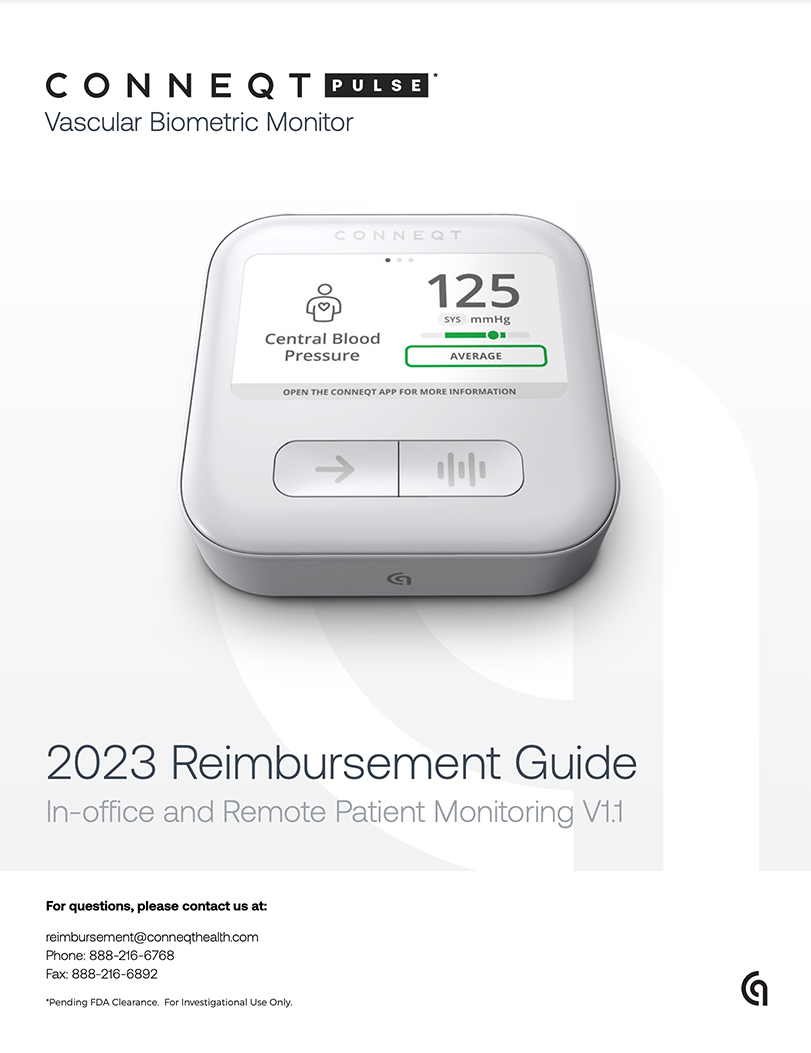Reimbursement
CONNEQT Pulse Physician Reimbursement
We are committed to ensuring the Pulse is accessible to every patient for whom a physician believes the monitor is medically necessary.
In 2016, the American Medical Association (AMA) approved CPT code 93050 for Pulse Wave Analysis (PWA) for the assessment of central arterial pressures to determine central arterial pressures and augmentation index.
More recently, the Centers for Medicare and Medicaid Services (CMS) have expanded CPT Remote Patient Monitoring (RPM) codes in response to the growing shift and demand for digital health programs.
These codes were developed for physicians and qualified medical professionals to obtain reimbursement for the time spent and the equipment used for patient care delivered using devices like the CONNEQT Pulse.
These procedures may be a covered service if they meet all of the requirements established by Medicare and private payors. It is essential that each claim be coded properly and supported with appropriate documentation in the medical record. The information is provided to assist you in understanding the reimbursement process. It is intended to assist providers in accurately obtaining reimbursement for health care services. It is not intended to increase or maximize reimbursement by any payor. We strongly suggest that you consult your payer organization with regard to local reimbursement policies. The information is provided for convenience only and represents no statement, promise or guarantee concerning levels of reimbursement, payment, or charge.
If you have additional questions on coding or billing, please reach out to a reimbursement specialist at: [email protected].
Phone: 888-216-6768
FAQs
What is Remote Physiologic Monitoring (RPM)?
RPM involves the collection and analysis of patient physiologic data that are used to develop and manage a treatment plan related to a chronic and/or acute health illness or condition. It allows patients to be monitored remotely while in their homes, and for providers to track patient’s physiologic parameters (e.g., weight, blood pressure, glucose) and implement changes to treatment as appropriate.
What kinds of devices can be used for RPM?
The device used must meet the FDA definition of a device as described in section 201(h) of the Federal Food, Drug and Cosmetic Act (FFDCA) and be ordered by a physician or other qualified healthcare provider. CONNEQT Pulse meets the FDA definition of a device.
Who can bill for RPM?
RPM can be ordered and billed only by physicians and non-physician healthcare providers who are eligible to bill Medicare for Evaluation and Management (E/M) services. The patient must be an established patient with the physician or eligible non-physician healthcare provider.
How often can RPM be reported?
RPM may be reported only once each 30 days (minimum of 16 patient readings over 30 days), after having completed an initial set-up and patient education on the use of the equipment.
How many days of monitoring are required to report 99453?
A minimum of 16 days of recording out of a 30-day period must be collected. If less than 16 days of recordings are collected, 99453 should not be reported. Within the reported period, there must be at least one interactive communication with the patient or caregiver.
If the patient is under the care of multiple HCPs, can RPM be billed more than once per patient in a 30-day period?
Multiple devices are reported under one code, even when multiple medical devices are provided to a patient by different healthcare practitioners, the services associated with all the medical devices can be billed only once per patient.
If different devices monitoring different parameters are used on a single patient during the same time period, can RPM be billed more than once?
Multiple devices are reported under one code, even when multiple medical devices are provided to a patient, the services associated with all the medical devices can be billed only once per patient.
Can 99091 be reported in the same 30-day period as RPM?
No, CPT parenthetical notes state that 99091 may not be reported in conjunction with 99457, 99458.
What is an episode of care?
According to CMS the “episode of care” begins “when the remote physiologic monitoring service is initiated and ends with attainment of targeted treatment goals.”


